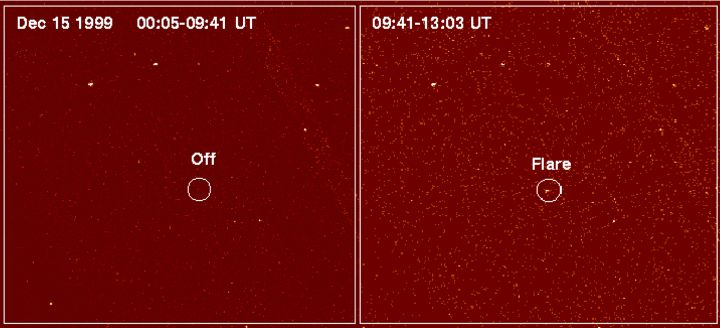Explanation: The tiny spot circled on the right actually represents a big astronomical discovery -- the first detected flare from a failed star. Failed stars, termed brown dwarfs in astronomers' parlance, are too low in mass to ignite nuclear hydrogen burning in their cores, yet still shine feebly as the energy from their gravitational collapse is converted to heat and light. In fact, the dim brown dwarf cataloged as LP944-20 is estimated to have only 6 percent the mass of the Sun (60 times the mass of Jupiter) and one-tenth the Sun's diameter. A mere 16 light-years distant in the southern constellation Fornax it is well studied, but this failed star recently startled astronomers by producing a flare visible at x-ray energies. The above Chandra X-ray Observatory images of the LP944-20 star field were recorded in December 1999. Showing nothing (left) for the first nine hours, the brown dwarf generated a significant x-ray flare during the final hours of the observation. How did a failed star produced such a high-energy flare? Magnetic fields twisted and broken by turbulent motions near the surface of the brown dwarf may be the culprit. Difficult to detect because they are otherwise faint, brown dwarf stars are believed to be common throughout the galaxy.
1999 2000 2001 2002 2003 2004 2005 2006 2007 2008 2009 2010 2011 2012 2013 2014 2015 2016 2017 2018 2019 2020 2021 2022 2023 2024 2025 |
Yanvar' Fevral' Mart Aprel' Mai Iyun' Iyul' Avgust Sentyabr' Oktyabr' Noyabr' Dekabr' |
NASA Web Site Statements, Warnings, and Disclaimers
NASA Official: Jay Norris. Specific rights apply.
A service of: LHEA at NASA / GSFC
& Michigan Tech. U.
|
Publikacii s klyuchevymi slovami:
flare - brown dwarf - star - korichnevyi karlik - vspyshka rentgenovskih luchei
Publikacii so slovami: flare - brown dwarf - star - korichnevyi karlik - vspyshka rentgenovskih luchei | |
Sm. takzhe:
Vse publikacii na tu zhe temu >> | |
